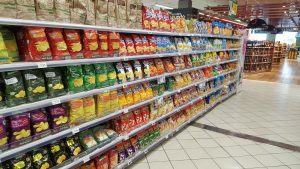Personalization is a key trend in the retail industry, with consumers increasingly expecting a shopping experience that is tailored to their individual needs. The role of in-store analytics in the rise of personalized retail experiences is becoming relevant because retailers can create personalized shopping experiences by using in-store data on customer behavior and interactions within physical retail spaces.
In-store analytics allows retailers to collect and analyze data on things like foot traffic, dwell time, product interactions, and more. This data can provide valuable insights into customer behavior and preferences, which can be used to tailor the shopping experience to individual customers.
This article explores the role of in-store analytics in the rise of personalized retail experiences and how it can be used to improve the customer experience, drive sales and revenue, and enhance operations and productivity. We’ll also look at the ways in which personalized retail experiences are likely to evolve in the future and the impact they will have on the retail industry.
The Benefits of In Store Analytics
In-store analytics offers numerous benefits for retailers looking to create personalized shopping experiences for their customers. By collecting and analyzing data on customer behavior and interactions within physical retail spaces, retailers can gain a deeper understanding of their customers and use this information to tailor the shopping experience to individual customers. Some of the key benefits of in-store analytics include:
- Personalization. In-store analytics allows retailers to tailor the shopping experience to individual customers based on their interests and past purchases. Retailers can provide personalized recommendations and offers, increasing the likelihood of a sale.
- Improved customer experience. In-store analytics can help retailers understand what attracts customers to their stores and what keeps them coming back. Retailers can identify areas for improvement and make changes to enhance the customer experience. Analyzing data on foot traffic, dwell time, product interactions, etc.
- Enhanced operations and productivity. Retailers can identify bottlenecks in their operations and make changes to improve efficiency. For example, using data on foot traffic and dwell time to optimize store layout and product placement. Furthermore, reduce the time it takes for customers to find what they’re looking for.
- Increased sales and revenue. By providing personalized recommendations and offers, in-store analytics helps to drive sales and revenue. Retailers can also use data on customer behavior and preferences to inform their product development and pricing strategies.
Overall, in-store data can provide valuable insights into customer behavior and preferences. Additionally, it helps retailers create personalized shopping experiences that drive sales and revenue.

In Store analytics in Personalization and Customer Experience
Personalization is a key trend in the retail industry. Consumers increasingly expect a shopping experience that is tailored to their individual preferences. In-store analytics can be a powerful tool for retailers looking to create personalized shopping experiences for their customers.

By collecting/analyzing data on customer behavior/interactions within physical retail spaces, retailers can gain a deeper understanding of their customers. Also, they can use this information to tailor the shopping experience to individual customers. This can include:
- Personalized recommendations and offers based on customer interests and past purchases
- Tailored in-store displays and promotions.
Personalization can also extend to the customer service experience. In-store analytics allows retailers to identify and address individual customer needs in real-time. For example, using in-store data to identify customers spending more time in certain areas of the store. Consequently, retailers can offer assistance or make product recommendations based on their interests and past purchases.
In summary, in-store analytics is a powerful tool for retailers looking to create personalized shopping experiences. By leveraging in-store data, retailers can stay ahead of the curve and remain competitive in today’s rapidly-changing retail landscape.
The Future of Personalized Retail Experiences
The future of personalized retail experiences looks bright. New technologies and approaches emerge to help retailers better understand and serve their customers. Some of the key trends and developments in the field of personalized retail experiences include:
- Increased use of artificial intelligence (AI) and machine learning. Retailers are increasingly using AI and machine learning to analyze and interpret data from in-store data systems. Concurrently, this helps retailers identify patterns and trends in customer behavior. Ultimately, make informed decisions about how to optimize the shopping experience.
- Greater integration with online data. As the gap between online and offline shopping continues to narrow, retailers see increased integration between in-store and online data. By combining data from both channels, retailers can get a more comprehensive view of their customers’ shopping habits and preferences. Basically, this information helps to tailor the shopping experience to individual customers.
- Consolidation of omnichannel retail: Omnichannel retail refers to a seamless shopping experience across multiple channels, including online, mobile, and in-store. As omnichannel retail becomes more prevalent, in-store analytics will play a key role in helping retailers understand and serve their customers across all channels.

Overall, the future of personalized retail experiences looks bright, with new technologies and approaches emerging to help retailers better understand and serve their customers. By leveraging in-store analytics and other technologies, retailers can stay ahead of the curve and remain competitive in today’s rapidly-changing retail landscape.
Conclusion
In conclusion, in-store analytics is a powerful tool for retailers looking to create personalized shopping experiences for their customers. By collecting and analyzing data on customer behavior and interactions within physical retail spaces, retailers can gain a deeper understanding of their customers and use this information to tailor the shopping experience to individual customers.
Overall, the use of in-store data is likely to continue evolving in the future. New technologies and approaches emerge to help retailers better understand and serve their customers. This includes the increased use of artificial intelligence and machine learning, greater integration with online data, and the rise of omnichannel retail.
Shoppermotion solutions provide in-store analytics to retailers. By using sensors, cameras, and other technologies, Shoppermotion gathers data on customer behavior and interactions within physical retail spaces in real time. This data provides retailers with valuable insights into customer behavior and preferences.
Lastly, whether you’re a small retailer just starting out or a large Retail Media Network looking to stay ahead of the curve, Shoppermotion’s in-store analytics solutions can help you create personalized shopping experiences that drive customer satisfaction and loyalty.






